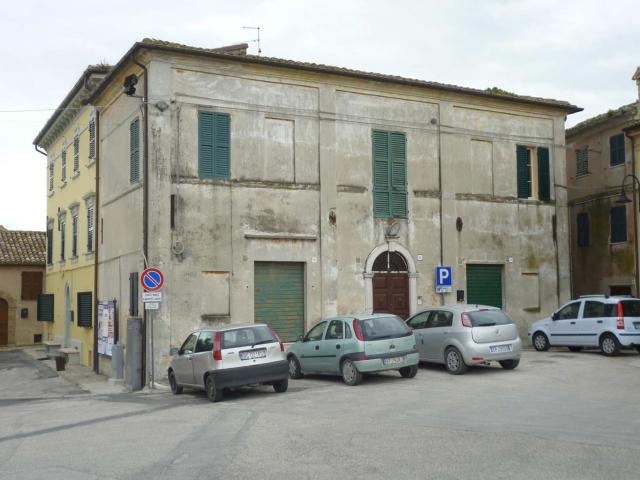This little borgo is mentioned in guidebooks for two things: for its excellent wine: Lacrima di Morro d’ Alba and the internal covered passageway (the “Scarpa”) built into its walls.
The former will not disappoint, and the latter has its charm, but a long stretch of the passageway is actually built on to a casa di riposo (old people’s home).Don’t be misled by the false impression that there is no more to the centro storico (historic centre) than the Scarpa and the old people’s home.
When you first arrive at the centro storico the temptation is to have a drink in the modest caffè
just outside the main gate
We visited this caffè on the morning of Ferragosto, 15 August, the Feast of the Assumption of Mary and a national holiday, so maybe we didn’t get a very good impression as the Signora was naturally keen to get off home for her festive lunch. It’s fine for coffee and cold drinks: no spremute, or freshly squeezed fruit juice; too far inland. See my blog post: A sideways look at Italian – or maybe Marchegiani – bars and caffes . While you’re in the caffè, enjoy the view of the main square with its classic Italian combination of the charming and the flyblown.
When you’ve done this, walk round the Scarpa
and enjoy the views,
but then explore the area inside the walls. It is very small, and for us the high point was a charming restaurant, Vin’Canta ,approached either from the Scarpa or from a little public garden. Here they were happy to serve us with a light snack of an excellent glass of Lacrima and some salumi (cold meats) even though it was lunchtime. Lacrima is very rich and fruity and I think the best of the Marchegiani red wines I have tasted. Others are Rosso Piceno and Rosso Conero.

The restaurant terrace, which gives on to the Scarpa.

Not actually a photograph of our food, but it gives you an idea.
(Photos courtesy of the comune’s website).
This was the end of our visit, but we had actually missed out on a fantastically located museum of rural life, the Museo Utensilia or Tools Museum, which is situated underground, below the Scarpa. This underground area, according to the website, is a dense network of caves and tunnels on two levels, one dating back to the seventeenth century and the lower one to the fourteenth and fifteenth centuries. We’ll be going back there, always assuming it’s open, of course, in May on our next visit to Le Marche. Basically it’s open on Sundays in the afternoon/early evening, with the odd Saturday at festa time. Follow the Museo Utensilia link for opening times.
The other thing we didn’t do was go on a tasting tour of the vineyards. If you are interested, there is plenty of information in Italian on the comune’s website, including a list of producers and a map of cantine. There is also an annual Sagra del vino Lacrima, or Lacrima festival, at the beginning of May, so you’d better hurry along.

Poster for Morro d’Alba Sagra

The sagra continues!
Photograph courtesy of the comune’s website and Promorro Pro Loco Morro d’Alba. Unless otherwise stated, all other photographs are by Edward Fennell.










Pingback: Morro d'Alba, home of Lacrima wine | Living in ...
Pingback: Return to Corinaldo (continued) | Hill towns of Le Marche, Italy